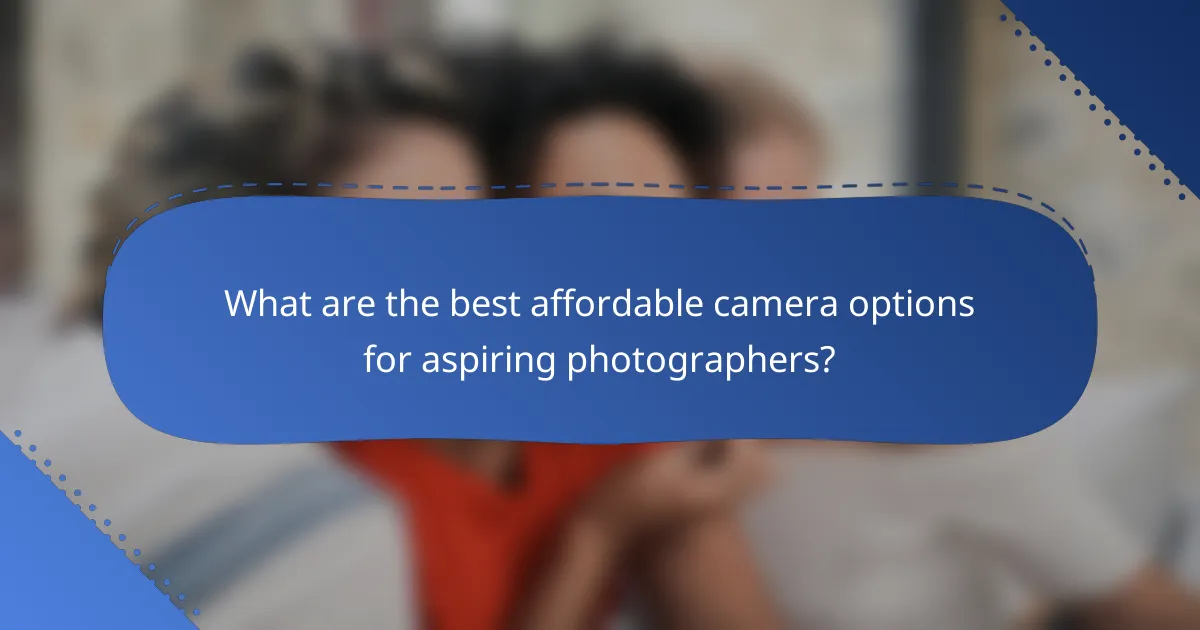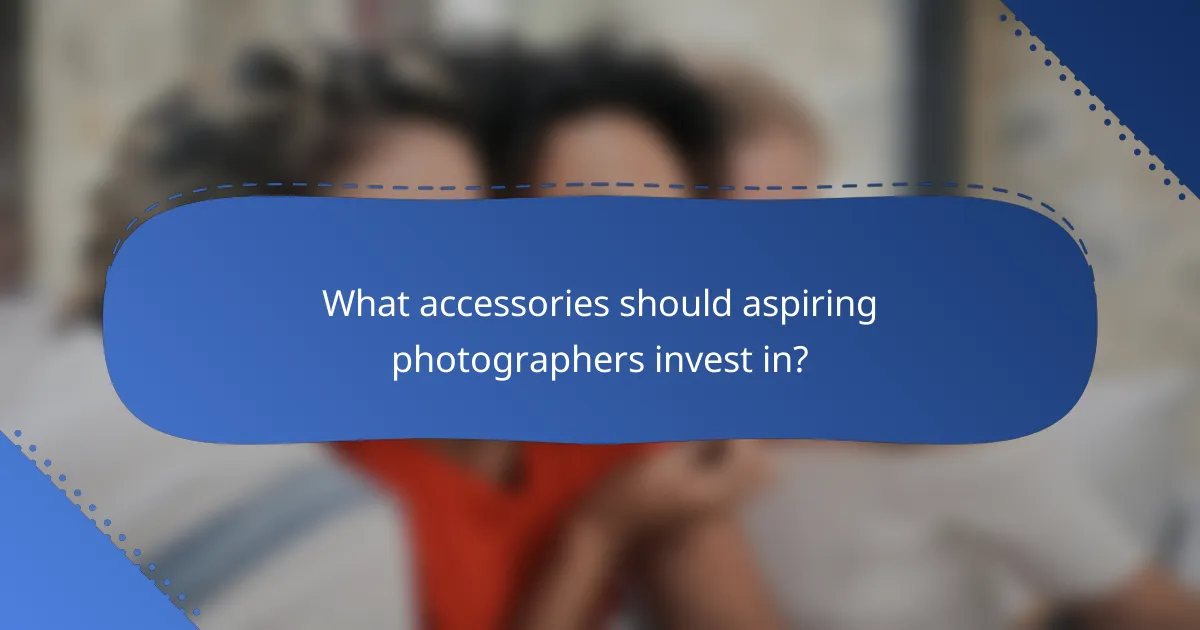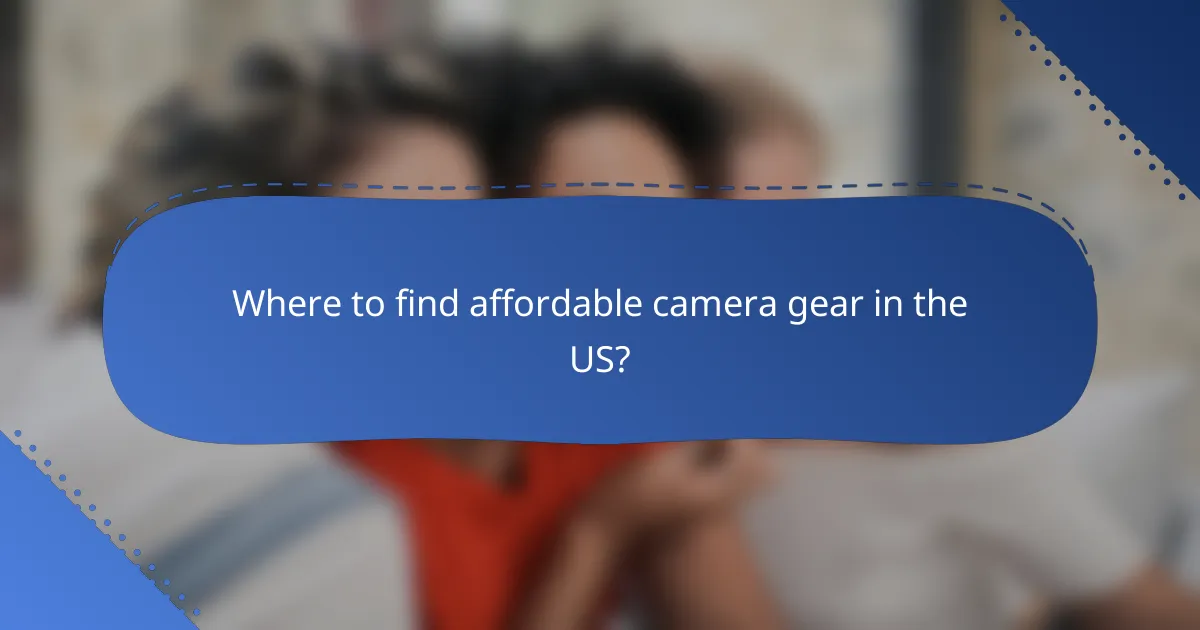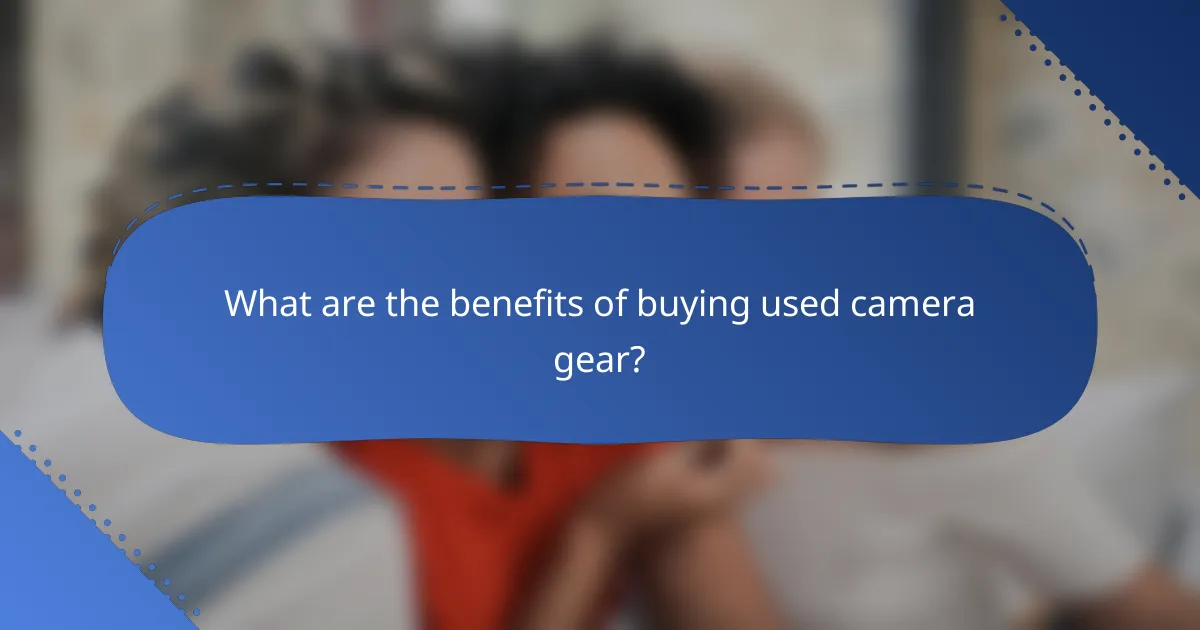For aspiring photographers, finding affordable camera gear that balances quality and usability is essential. Typically priced between $400 and $800, entry-level DSLRs and mirrorless models provide excellent performance without breaking the bank. Understanding your photography needs and budget will help you select the right equipment, while investing in essential accessories can further enhance your shooting experience.

What are the best affordable camera options for aspiring photographers?
For aspiring photographers, the best affordable camera options combine quality, ease of use, and versatility. These cameras typically range from entry-level DSLRs to mirrorless models, offering a balance of performance and price, often between $400 and $800.
Nikon D3500
The Nikon D3500 is a popular choice for beginners due to its user-friendly interface and solid image quality. It features a 24.2 MP sensor, which captures sharp and vibrant images, making it suitable for various photography styles.
This camera offers a Guide Mode that helps new users understand settings and techniques, making it easier to learn photography basics. With a price point around $500, it provides excellent value for those starting their photography journey.
Canon EOS Rebel T7
The Canon EOS Rebel T7 is another excellent entry-level DSLR, known for its intuitive controls and reliable performance. It boasts a 24.1 MP sensor and built-in Wi-Fi, allowing for easy sharing of photos directly from the camera.
Priced similarly to the D3500, around $450, the T7 is ideal for those who want to explore photography without a steep learning curve. Its compatibility with a wide range of Canon lenses also offers flexibility as skills develop.
Sony Alpha a6000
The Sony Alpha a6000 is a compact mirrorless camera that appeals to aspiring photographers seeking portability without sacrificing quality. With a 24.3 MP sensor and fast autofocus, it excels in capturing action shots and low-light conditions.
At approximately $600, the a6000 is a great option for those who prefer a lightweight system. Its interchangeable lens capability and advanced features make it a versatile choice for various photography styles.
Fujifilm X-T200
The Fujifilm X-T200 stands out with its retro design and excellent color reproduction, making it a favorite among creative photographers. It features a 24.2 MP sensor and a user-friendly touchscreen interface, enhancing the shooting experience.
With a price tag around $700, the X-T200 is ideal for those who appreciate aesthetics and functionality. Its film simulation modes allow users to experiment with different looks right in-camera.
Olympus OM-D E-M10 Mark III
The Olympus OM-D E-M10 Mark III is a compact mirrorless camera that offers impressive image stabilization and a variety of creative shooting modes. Its 16 MP sensor delivers high-quality images, and the camera’s lightweight design makes it easy to carry.
Priced around $600, this camera is perfect for photographers who value portability and advanced features. The E-M10 Mark III’s built-in art filters enable users to add unique effects to their photos effortlessly.

How to choose the right camera gear?
Choosing the right camera gear involves understanding your photography needs, budget, and the reliability of brands. Focus on what type of photography you want to pursue, how much you can spend, and which brands have a good reputation for quality and service.
Consider your photography style
Your photography style significantly influences the type of gear you need. For instance, if you enjoy landscape photography, a camera with a high-resolution sensor and a wide-angle lens is essential. Conversely, portrait photographers may prioritize lenses with wide apertures for beautiful bokeh effects.
Think about whether you prefer shooting in natural light or need a camera that performs well in low-light conditions. This will guide your choice of camera body and lens specifications.
Evaluate your budget
Setting a budget is crucial when selecting camera gear. Entry-level DSLRs or mirrorless cameras typically range from $400 to $800, while lenses can vary widely, with good options starting around $200. Consider allocating funds not just for the camera but also for essential accessories like tripods, memory cards, and bags.
Be cautious of overspending on features you may not use. Prioritize essential gear first, and consider upgrading as your skills and needs evolve.
Research brand reliability
Brand reliability is vital for ensuring your investment lasts. Popular brands like Canon, Nikon, and Sony have established reputations for quality and customer support. Look for user reviews and professional recommendations to gauge the reliability of specific models.
Additionally, consider the availability of service centers and warranty options in your area. A reliable brand can save you time and money in repairs or replacements down the line.

What accessories should aspiring photographers invest in?
Aspiring photographers should invest in accessories that enhance their shooting experience and improve image quality. Key items include tripods for stability, external flashes for better lighting, camera bags for protection, and memory cards for ample storage.
Tripods for stability
Tripods are essential for achieving stability in photography, especially in low-light conditions or when using long exposure techniques. Look for models that are lightweight yet sturdy, with adjustable heights and quick-release plates for convenience.
When selecting a tripod, consider the weight it can support and its compatibility with your camera type. A good range for aspiring photographers is a tripod that can hold at least double the weight of your camera and lens combined.
External flashes for lighting
External flashes significantly improve lighting quality, allowing for better control over exposure and shadows. They provide more power than built-in flashes and can be positioned away from the camera for creative lighting effects.
When choosing an external flash, look for features like adjustable power settings, swivel heads, and compatibility with your camera brand. Prices can vary widely, but investing in a reliable flash can enhance your photography significantly.
Camera bags for protection
A good camera bag is crucial for protecting your gear while on the go. Look for bags that offer padded compartments, weather resistance, and easy access to your equipment.
Consider the size and style of the bag based on your shooting habits. Backpack-style bags are great for hiking, while shoulder bags offer quick access in urban settings. Aim for a bag that fits your camera, lenses, and any additional accessories comfortably.
Memory cards for storage
Memory cards are vital for storing your photos and videos, so investing in high-quality options is essential. Look for cards with fast write speeds, especially if you shoot in burst mode or record high-definition video.
Common capacities range from 32GB to 256GB, with larger sizes suitable for extensive shooting sessions. Always check the compatibility of the memory card with your camera and consider having multiple cards on hand to avoid running out of space during shoots.

Where to find affordable camera gear in the US?
Affordable camera gear can be found through various channels in the US, including online retailers, local shops, and second-hand marketplaces. Each option has its advantages, so consider your budget and preferences when choosing where to shop.
Online retailers like B&H Photo
Online retailers such as B&H Photo offer a wide range of camera gear at competitive prices. They often have sales, discounts, and a vast selection of both new and used equipment, making it easier to find budget-friendly options.
When shopping online, pay attention to shipping costs and return policies. Many retailers provide free shipping on orders over a certain amount, which can help you save further.
Local camera shops
Local camera shops can be a great resource for affordable gear, especially if you prefer to see products in person. These shops often have knowledgeable staff who can provide personalized advice and recommendations based on your photography needs.
While prices may vary, local shops sometimes offer used equipment at lower prices. Don’t hesitate to ask about any ongoing promotions or discounts for first-time customers.
Second-hand marketplaces like KEH
Second-hand marketplaces like KEH specialize in used camera gear, often at significantly reduced prices. These platforms allow you to find high-quality equipment that has been inspected and rated for condition, providing peace of mind with your purchase.
When buying used gear, check the return policy and warranty options. This can help protect your investment in case the equipment does not meet your expectations or has hidden issues.

What are the benefits of buying used camera gear?
Buying used camera gear offers significant advantages, particularly for aspiring photographers looking to maximize their budget. It allows access to high-quality equipment at lower prices, making photography more accessible without sacrificing quality.
Cost savings
One of the primary benefits of purchasing used camera gear is the substantial cost savings. Prices for used equipment can often be 30-50% lower than new items, depending on the brand and condition. This allows photographers to invest in better lenses or accessories without exceeding their budget.
When shopping for used gear, consider platforms like eBay, KEH, or local camera shops that offer trade-ins. Always check for warranties or return policies to mitigate risks associated with buying second-hand.
Access to discontinued models
Buying used camera gear provides access to discontinued models that may no longer be available in stores. Many photographers prefer older models for their unique features or build quality, which can sometimes outperform newer alternatives.
For instance, certain vintage lenses are sought after for their distinct character and optical qualities. Researching specific models and their reputations can help you find valuable equipment that suits your style.
Environmental sustainability
Purchasing used camera gear contributes to environmental sustainability by reducing waste and promoting recycling. By choosing second-hand equipment, you help extend the lifecycle of products and minimize the demand for new manufacturing, which can be resource-intensive.
Additionally, many used items can be refurbished or repaired, further decreasing environmental impact. Consider supporting local businesses or online marketplaces that prioritize sustainability in their operations.
